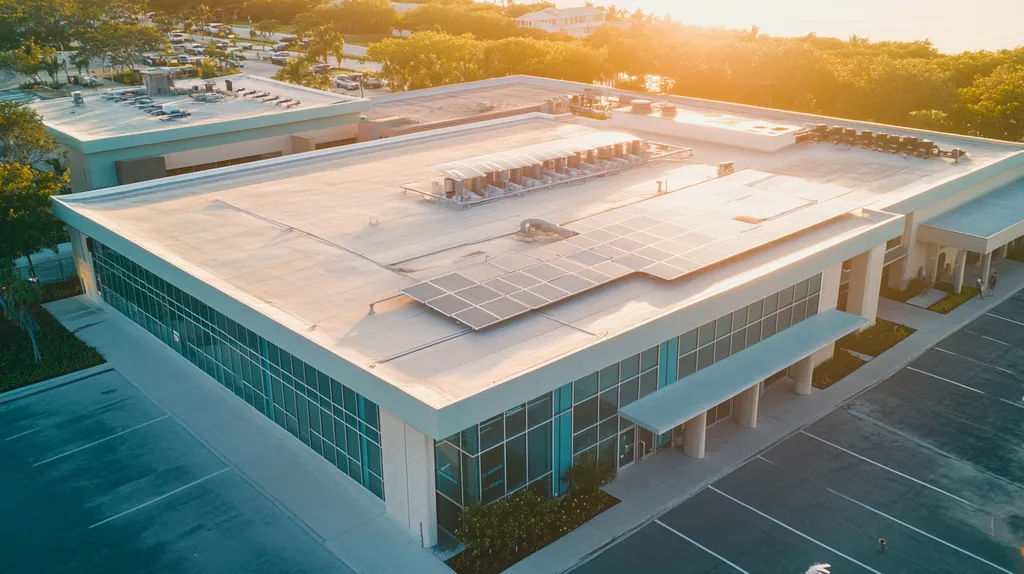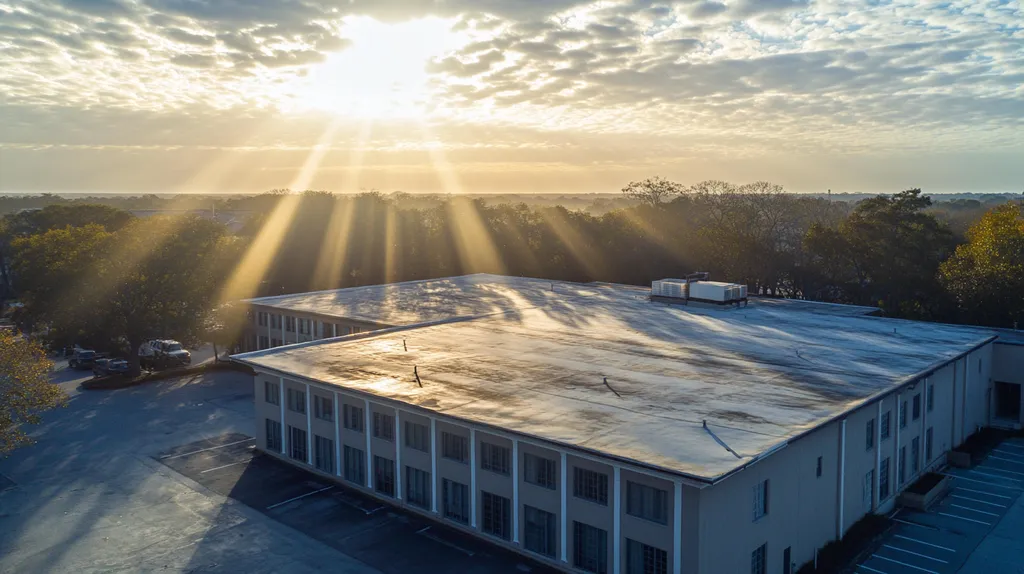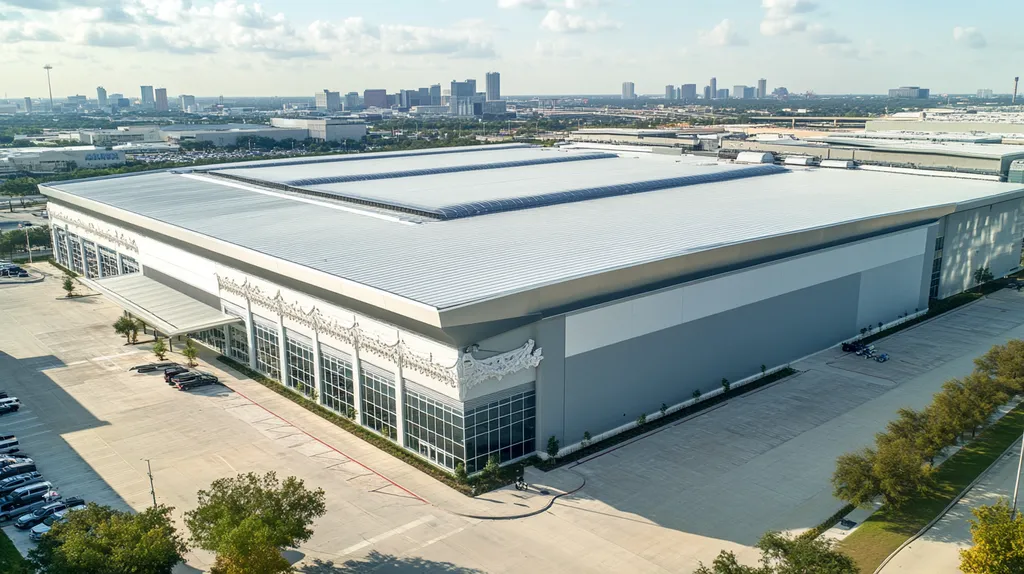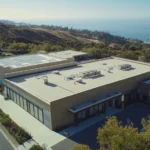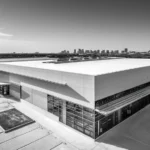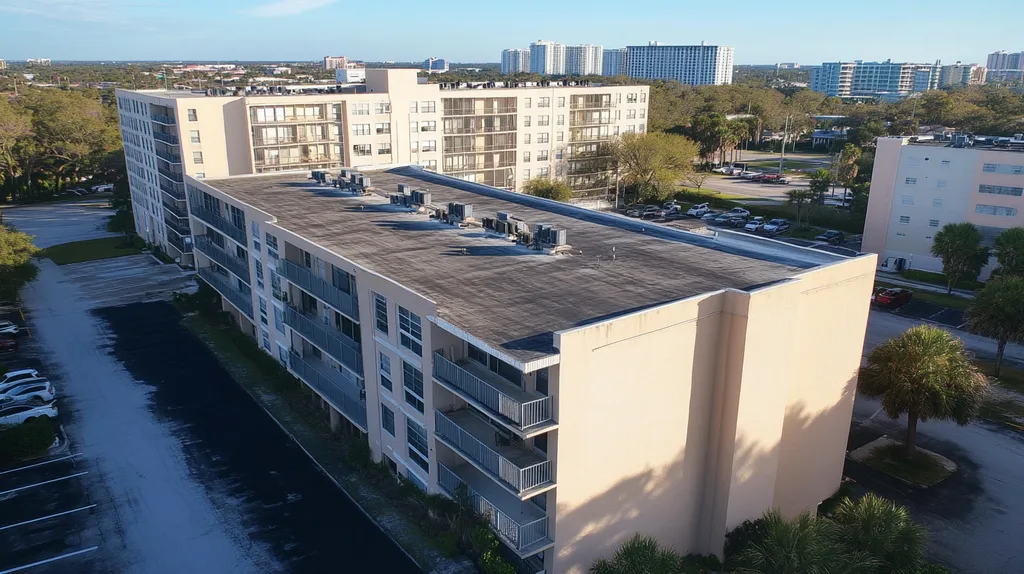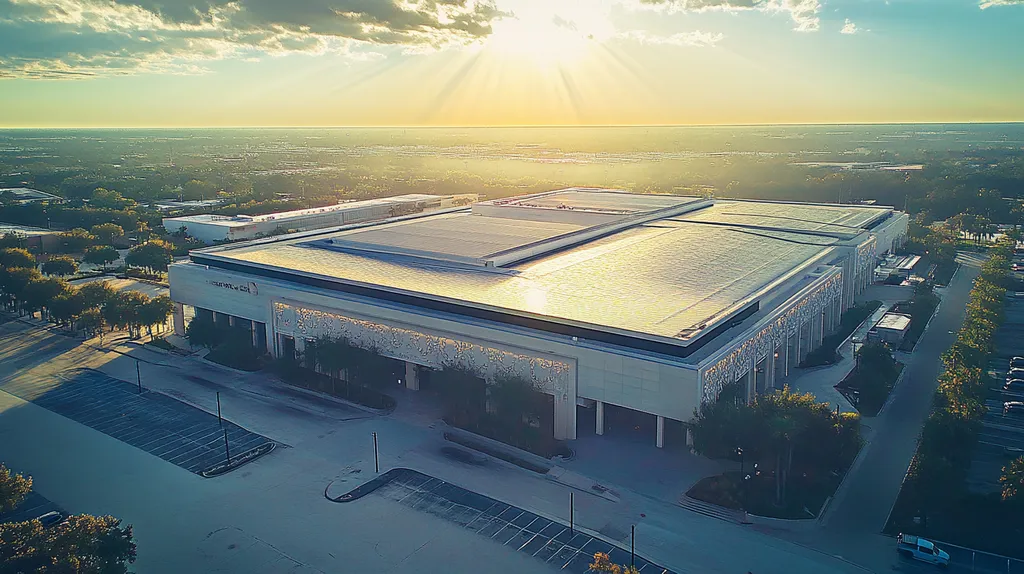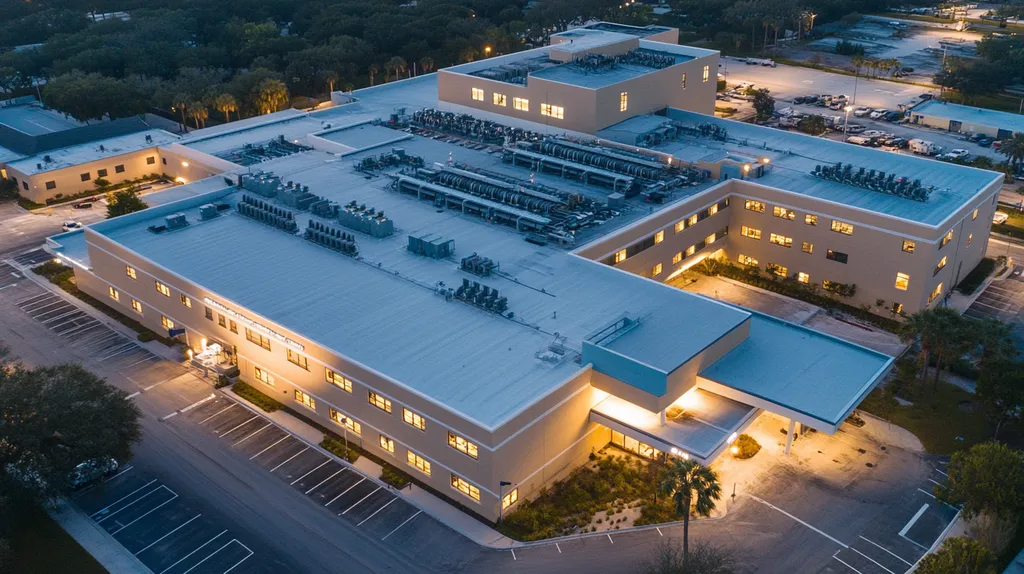Each year, commercial roofing projects generate over 20 billion pounds of waste in North America, with 95% of materials being recyclable but only 10% actually getting recycled.
This massive waste of reusable resources costs businesses millions in unnecessary disposal fees while filling landfills at an unsustainable rate.
Modern recycling technologies and processes now make it possible to recover and repurpose nearly every component of a commercial roof system, from membrane materials to insulation boards.
This comprehensive guide examines the fundamental concepts, implementation methods, and optimization strategies that facility managers need to transform their roof replacement projects from environmental liabilities into sustainable assets.
SECTION 1: FUNDAMENTAL CONCEPTS
Each year, commercial roof replacements generate over 20 billion pounds of waste material in North America alone. This mounting crisis threatens both environmental sustainability and business bottom lines as landfill costs continue to rise. Understanding and implementing effective recycling strategies has become critical for property owners and facility managers seeking to balance environmental responsibility with financial performance.
Introduction to Roof Material Recycling
Modern commercial roofing recycling goes far beyond basic waste sorting. Today’s advanced processes can recover and repurpose nearly every component of an existing roof system, from membrane materials to insulation boards.
The most commonly recycled materials include EPDM rubber, TPO membranes, metal flashings, and polyisocyanurate insulation boards. These materials can be processed into raw components for manufacturing new roofing products or repurposed for other industries.
Recent innovations have expanded recycling capabilities to handle complex multi-layer systems. Even challenging materials like adhesives and coatings can now be separated and reclaimed through specialized processing.
The EPA has documented significant advances in recycling technologies, including new polymer-based systems that incorporate recycled materials while improving energy efficiency and durability. (source: EPA)
Benefits of Recycling in Roofing
Direct cost savings represent the most immediate benefit of roof recycling. Diverting materials from landfills can reduce disposal fees by 30-50% on typical commercial projects.
Environmental benefits extend throughout the supply chain. Recycling one ton of roofing membrane saves approximately 2.5 barrels of oil and reduces carbon emissions by 1.5 metric tons.
Many jurisdictions now offer tax incentives and LEED credits for documented recycling efforts. These programs can offset project costs while enhancing property values through green building certification.
Recycling programs also strengthen contractor relationships by demonstrating shared commitment to sustainability goals. This alignment often leads to more competitive pricing and priority service.
Industry Recycling Standards
The roofing industry has developed comprehensive standards for material recycling through organizations like the National Roofing Contractors Association (NRCA) and the Recycling Certification Institute (RCI).
These standards establish specific protocols for handling different material types. For example, membrane recycling requires careful separation of adhesives and proper sorting by polymer type to ensure maximum recovery value.
Quality control measures verify that recycled materials meet performance requirements. Regular testing ensures recycled content maintains structural integrity and weathering resistance equal to virgin materials.
Documentation requirements track materials from removal through processing. This chain of custody provides verification for regulatory compliance and green building certification programs.
SECTION 2: SYSTEM COMPONENTS
The commercial roofing sector faces a critical challenge – while over 95% of roofing materials can be recycled, most still end up in landfills. Understanding recyclable components and their processing requirements has become essential as disposal costs rise and environmental regulations tighten. Today’s advanced recycling technologies can transform nearly every roofing component into valuable raw materials, from metal panels to synthetic membranes.
Overview of Recyclable Roof Materials
Commercial roofing systems contain multiple recyclable layers that can be separated and processed. The most commonly recycled components include metal flashings, EPDM rubber membranes, TPO sheets, and polyisocyanurate insulation boards.
Recent technological advances now allow for recycling of previously challenging materials like adhesives and coatings. The EPA has documented innovative processes that combine recycled materials with virgin polymers to create high-performance roof coatings with minimal environmental impact. (source: EPA)
Even built-up roofing systems with multiple material layers can now be separated and processed. Modern recycling facilities use specialized equipment to sort and clean materials while maintaining their structural properties.
Understanding material composition helps determine optimal recycling pathways. Different polymers and metals require specific handling procedures to maximize recovery value and ensure quality in recycled products.
Metal Roofing Recycling Mechanics
Metal roofing components offer the highest recycling value and efficiency among all roofing materials. Steel and aluminum panels can be recycled indefinitely without losing structural integrity or performance characteristics.
The recycling process begins with magnetic separation to sort ferrous and non-ferrous metals. Specialized shredders then reduce panels to uniform sizes while removing contaminants and non-metallic materials.
Modern facilities use advanced melting systems that preserve metal alloy compositions. This ensures recycled content meets or exceeds specifications for new roofing products.
Recycled metal reduces energy consumption by up to 95% compared to mining and refining raw materials. This energy savings translates directly to reduced carbon emissions and operating costs.
EPDM and TPO Recycling Processes
Single-ply membrane recycling requires careful removal and sorting to maintain material purity. Specialized equipment separates membrane sheets from adhesives and other contaminants without damaging the base polymers.
EPDM recycling converts used membranes into rubber crumb through multi-stage grinding processes. This recycled rubber becomes raw material for new roofing products, walkway pads, and other construction materials.
TPO membranes undergo precision shredding before being reformed into pellets. Advanced processing maintains the material’s key properties, allowing direct reuse in manufacturing new roofing sheets.
Quality control testing ensures recycled membrane materials meet performance standards. Regular monitoring of physical properties and chemical composition verifies suitability for remanufacturing.
SECTION 3: IMPLEMENTATION METHODS
The commercial roofing industry stands at a critical crossroads in waste management. While traditional disposal methods send millions of tons of reusable materials to landfills annually, innovative recycling approaches can transform this waste stream into valuable resources. Implementing effective recycling strategies requires careful planning across three key areas: initial material separation, on-site processing, and strategic partnerships with recycling facilities.
Sorting and Processing Roof Waste
Successful recycling begins with systematic material separation during tear-off. Different roofing components require specific handling procedures to maintain their recycling value and prevent cross-contamination.
More than 98% of vinyl roofing materials can be converted into new membranes when properly sorted and processed. Over 2.3 billion square feet of new roofing membrane now contains recycled PVC across thousands of commercial projects. (source: Sika USA)
Metal components should be separated into ferrous and non-ferrous categories. Clean separation dramatically increases the market value of recycled metals while ensuring optimal processing efficiency.
Insulation materials require protection from moisture contamination during sorting. Dry, uncontaminated insulation boards can be processed into new products, while wet materials may require alternative disposal methods.
On-Site Recycling Techniques
Mobile processing equipment brings recycling capabilities directly to the job site. Portable grinders can reduce bulky materials into manageable sizes while minimizing transportation costs.
Strategic staging areas help maintain material separation throughout the project. Designated zones for different material types prevent mixing and contamination while maximizing space efficiency.
Weather protection systems safeguard sorted materials until processing. Temporary covers and containment systems prevent moisture damage and material loss during extended projects.
Regular quality control checks ensure materials maintain their recycling value. Testing throughout the process verifies that handling methods preserve material integrity.
Off-Site Material Disposal Strategies
Partnership networks with specialized recycling facilities maximize material recovery. Different facilities often specialize in specific material types, requiring coordinated logistics planning.
Transportation optimization reduces both costs and environmental impact. Consolidated shipments and back-hauling arrangements improve efficiency while minimizing carbon emissions.
Documentation systems track materials from removal through final processing. Complete chain of custody records support environmental compliance and verify recycling performance.
Regular audits of recycling partners ensure continued program effectiveness. Performance metrics help identify opportunities for improvement while maintaining quality standards.
SECTION 4: MAINTENANCE REQUIREMENTS
Maintaining roofs with recycled materials requires specialized knowledge and systematic care to maximize performance and longevity. While recycled components can match or exceed the durability of virgin materials, proper maintenance becomes even more critical to protect the investment. Research shows that well-maintained recycled roofing systems can last 20-25% longer than those receiving only reactive maintenance.
Post-Recycling Roof Condition Assessment
Initial assessments must establish clear performance benchmarks within 30 days of installation. These evaluations focus on seam integrity, membrane adhesion, and drainage patterns to identify any early installation issues.
Modern assessment protocols incorporate thermal imaging and moisture mapping to detect potential problems invisible to the naked eye. This technology can identify trapped moisture or delamination before they lead to system failure.
Recycled PVC roofing membranes can maintain their performance characteristics for over 20 years when properly monitored and maintained. Over 95% of these materials can be recycled again into new membrane products at the end of their service life. (source: Roofing Elements Magazine)
Documentation from assessments creates a baseline for future comparisons and warranty validation. This data helps facility managers track system performance and anticipate maintenance needs.
Preventative Care for Recycled Roofs
Quarterly inspections should focus on high-stress areas including membrane seams, flashings, and drainage points. These vulnerable zones often show the first signs of potential system failure.
Debris removal and surface cleaning prevent chemical degradation and biological growth. Different recycled materials may require specific cleaning protocols to prevent damage to protective coatings.
Drainage system maintenance becomes particularly critical for recycled membrane systems. Even minor ponding can accelerate material breakdown and void warranty coverage.
Weather monitoring helps anticipate and prevent storm-related damage. Facility managers should implement enhanced inspection schedules during extreme weather seasons.
Extended Warranty Options
Warranty programs for recycled roofing systems typically require documented maintenance compliance. Manufacturers may specify inspection intervals and maintenance procedures necessary to maintain coverage.
Enhanced warranty options often include preventative maintenance services performed by certified contractors. These programs can reduce long-term costs while ensuring proper care of recycled materials.
Performance-based warranties may offer additional coverage based on documented maintenance history. These programs incentivize proper care while protecting the facility’s investment.
Regular warranty reviews ensure compliance with current maintenance requirements. Changes in building use or local weather patterns may necessitate updates to maintenance protocols.
SECTION 5: PERFORMANCE METRICS
Measuring the impact of roofing material recycling has become essential as disposal costs rise and environmental regulations tighten. Current data shows that while commercial roof replacements generate over 20 billion pounds of waste annually in North America, implementing strategic recycling programs can divert up to 85% of materials from landfills while delivering measurable cost savings and energy benefits. Understanding these metrics helps property owners make informed decisions that balance environmental responsibility with financial performance.
Environmental Impact Assessments
Environmental impact tracking begins with accurate waste diversion measurements. Modern recycling programs can now process virtually every component of a commercial roof system, from membrane materials to insulation boards.
Vinyl roofing materials demonstrate exceptional recyclability, with PVC membranes being transformed into new roofing products that perform as well as those made from virgin materials. These recycled membranes maintain their performance characteristics even after decades of service. (source: Roofing Elements Magazine)
Carbon footprint reduction represents another key metric. Each ton of recycled roofing material prevents approximately 2.5 metric tons of carbon emissions through reduced manufacturing energy and transportation requirements.
Water conservation impacts must also be considered. Recycling processes typically use 95% less water than manufacturing new materials, while proper material sorting prevents contaminated runoff at disposal sites.
Cost Savings through Recycling
Direct disposal cost reductions provide the most immediate financial benefit. Current landfill fees average $85-150 per ton for roofing waste, while recycling costs typically range from $35-65 per ton.
Transportation expenses decrease significantly when materials are processed for recycling. Reduced volume and weight can cut hauling costs by 40-60% compared to traditional disposal methods.
Tax incentives and rebate programs can further improve financial returns. Many jurisdictions offer credits ranging from $5-15 per ton for documented recycling efforts.
Long-term savings accumulate through reduced material costs. Manufacturers often provide preferential pricing for projects incorporating recycled content, helping offset initial recycling investments.
Energy Efficiency Gains
Recycled roofing materials often deliver superior energy performance. Advanced processing techniques can enhance thermal properties while maintaining structural integrity.
Cool roof characteristics frequently improve with recycled content. Refined polymers and enhanced surfacing options can increase solar reflectivity by 10-15% compared to traditional materials.
Insulation value optimization becomes possible through precise material recovery. Careful processing preserves R-value while allowing custom density adjustments for specific climate zones.
Building energy consumption typically decreases 15-25% with properly recycled and reinstalled roofing systems. These savings compound annually while reducing overall environmental impact.
SECTION 6: OPTIMIZATION STRATEGIES
Commercial roof recycling has reached a critical inflection point. While traditional disposal methods send billions of pounds of reusable materials to landfills each year, innovative optimization strategies can transform this waste stream into valuable assets. Modern recycling technologies now enable property owners to extend roof lifespans, reduce replacement costs, and achieve ambitious sustainability goals through strategic material recovery and reuse.
Enhancing Roof Lifespan through Recycling
Strategic recycling practices directly impact roof longevity by enabling targeted material recovery and restoration. Advanced polymer recycling systems can now transform aging roof coatings into high-performance repair materials that extend service life while improving energy efficiency.
These innovative coating systems incorporate recycled materials to create barriers more than 10 times thicker than conventional repairs, dramatically improving both durability and thermal performance. The enhanced UV and infrared reflection can reduce cooling costs by up to 15% while preventing premature membrane degradation. (source: EPA)
Regular assessment of recyclable components helps identify opportunities for material restoration before replacement becomes necessary. This proactive approach catches minor issues before they escalate into major problems requiring complete tear-offs.
Documentation of recycling efforts creates valuable performance data that informs maintenance planning. Tracking which materials respond best to recycling helps optimize future repair and replacement decisions.
Leveraging Recycled Materials in New Roofs
Modern manufacturing processes can incorporate significant percentages of recycled content without compromising performance. Advanced separation and cleaning technologies preserve the key properties of recovered materials while removing contaminants.
Quality control measures verify that recycled materials meet or exceed original specifications. Regular testing of physical properties ensures consistent performance throughout the manufacturing process.
Strategic material selection maximizes the benefits of recycled content. Different components require specific processing approaches to maintain their structural integrity and weathering resistance.
Cost analysis demonstrates the financial advantages of recycled materials. Reduced raw material requirements and processing efficiency improvements help offset initial recycling investments.
Integration with Green Building Initiatives
Roofing recycling programs directly support key green building objectives. Material recovery reduces environmental impact while contributing to waste reduction targets and certification requirements.
Documentation systems track recycling metrics for green building credits. Chain of custody records verify material handling compliance throughout the recycling process.
Energy performance benefits enhance overall building sustainability. Improved thermal properties and reflectivity reduce HVAC loads while supporting energy efficiency goals.
Partnership networks strengthen program effectiveness through shared expertise. Collaboration between property owners, contractors, and recyclers creates innovative solutions for challenging materials.
The Bottom Line
With over 20 billion pounds of roofing waste generated annually and landfill costs continuing to rise, the commercial roofing industry can no longer ignore the imperative to recycle.
Modern recycling technologies now make it possible to recover and repurpose up to 95% of roofing materials, delivering cost savings of 30-50% compared to traditional disposal methods.
The environmental impact is equally significant, with each ton of recycled material preventing 2.5 metric tons of carbon emissions while conserving valuable resources.
As regulations tighten and sustainability becomes a business imperative, property owners who implement comprehensive recycling programs will gain competitive advantages through reduced costs, enhanced building performance, and strengthened environmental credentials.
FREQUENTLY ASKED QUESTIONS
Q. What is commercial roof material recycling?
A. It’s the process of recovering used materials from a roof replacement to minimize waste. Effective recycling strategies can repurpose components like membranes, insulation, and metals, significantly reducing landfill usage and disposal costs.
Q. What recyclable materials can be found in an industrial roof?
A. Common recyclable materials include metal flashings, EPDM membranes, TPO sheets, and polyisocyanurate insulation. These components can be processed and reused, contributing to sustainable roofing practices.
Q. How can commercial roof waste be sorted for recycling?
A. Sorting should happen during tear-off, categorizing materials by type to prevent contamination. This ensures maximum recovery value and enhances processing efficiency in recycling facilities.
Q. What maintenance is needed for recycled roofs?
A. Regular inspections, debris removal, and moisture management are essential for maintaining recycled roofs. Proper care maximizes their lifespan and ensures they perform effectively throughout their service life.
Q. How do I measure the benefits of my commercial roof recycling efforts?
A. Track waste diversion and calculate cost savings from reduced disposal fees. Analyzing energy savings and environmental impacts also provides insight into the success of recycling initiatives.
Q. Are there green building certifications for recycled roofing materials?
A. Yes, many green building certifications, like LEED, reward initiatives that include recycling efforts. Proper documentation of recycling can contribute to achieving certification goals, enhancing your building’s sustainability profile.
Q. What are the long-term benefits of recycled commercial roofing materials?
A. Long-term benefits include reduced material costs and improved energy efficiency. Recycled materials can lower operational costs while extending the roof’s lifespan and performance, promoting sustainability.

